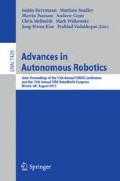Abstract
The paper explores the benefits of using continuous curvature 2D paths in obstacle avoidance methods in terms of safety and comfort. To this end the paper proposes a novel contribution by introducing clothoid-based smooth paths for non-holonomic robots defined from Cartesian (x,y) and angular velocities, as if they were intended to be applied to holonomic robots. To remark, these paths, coined as quasi-holonomic continuous curvature paths (QHCC), generate purely non-holonomic motions (combinations of linear and angular velocities) that mimic a holonomic motion. In fact, QHCC paths converge to the same asymptotic direction pointed by the holonomic motion while taking into account kinematic and dynamic constraints. In the paper, we show how these paths can be used and integrated in well-known obstacle avoidance algorithms such as Nearness Diagram (ND) and Dynamic Window Approach (DWA), among others. In addition to this, an ANN has been trained to considerably speed-up the path generation process and to learn the intrinsics of the path. Additionally, the paper shows the advantages of the proposed method over standard obstacle avoidance algorithms.
Access this chapter
Tax calculation will be finalised at checkout
Purchases are for personal use only
Preview
Unable to display preview. Download preview PDF.
References
Marchionna, A., Perco, P.: A proposal to update the clothoid parameter limiting criteria of the italian standard. In: Int. Società Italiana Infrastrutture Viarie Congress (2007)
Latombe, J.C.: Robot Motion Planning. Kluwer Academic Press (1991)
Ulrich, I., Borenstein, J.: Vfh*: Local obstacle avoidance with look-ahead verification. In: IEEE Int. Conf. Robotics and Automation, pp. 2505–2511 (2001)
Minguez, J., Montano, L.: Nearness diagram (nd) navigation: Collision avoidance in troublesome scenarios. IEEE Transactions on Robotics and Automation 1(20), 45–59 (2004)
Fox, D., Burgard, W., Thrun, S.: The dynamic window approach to collision avoidance. IEEE Robotics Automation Magazine 4(1), 23–33 (1997)
Marder-Eppstein, E., Berger, E., Foote, T., Gerkey, B.P., Konolige, K.: The office marathon: Robust navigation in an indoor office environment. In: International Conference on Robotics and Automation (May 2010)
Jaillet, L., Cortés, J., Siméon, T.: Sampling-based path planning on configuration-space costmaps. Trans. Rob. 26, 635–646 (2010)
Minguez, J., Montano, L.: Extending collision avoidance methods to consider the vehicle shape, the kinematics, and dynamics of a mobile robot. IEEE Transaction on Robotics 25(2), 367–381 (2009)
Donald, B., Xavier, P., Canny, J., Reif, J.: Kinodynamic motion planning. J. ACM 40, 1048–1066 (1993), http://doi.acm.org/10.1145/174147.174150
Scheuer, A., Fraichard, T.: Continuous-curvature path planning for car-like vehicles. In: IEEE Int. Conf. on Intelligent Robots and Systems, vol. 2, pp. 997–1003 (1997)
Fraichard, T., Scheuer, A.: From reeds and shepp’s to continuous-curvature paths. IEEE Trans. on Robotics and Automation 20(6), 1025–1035 (2004)
Yang, K., Sukkarieh, S.: Real-time continuous curvature path planning of uavs in cluttered environments. In: Int. Symp. on Mechatronics and its Applications (2008)
Labakhua, L., Nunes, U., Rodrigues, R., Leite, F.S.: Smooth trajectory planning for fully automated passengers vehicles. spline and clothoid based methods and its simulation. In: Informatics in Control Automation and Robotics. Springer (2008)
Wilde, D.K.: Computing clothoid segments for trajectory generation. In: IEEE Int. Conf. on Intelligent Robots and Systems, pp. 2440–2445 (2009)
Manz, M., von Hundelshausen, F., Wuensche, H.-J.: A hybrid estimation approach for autonomous dirt road following using multiple clothoid segments. In: IEEE Int. Conf. on Robotics and Automation, pp. 2410–2415 (2010)
Girbés, V., Armesto, L., Tornero, J.: On generating continuous-curvature paths for line following problem with curvature and sharpness constraints. In: IEEE Int. Conf. on Robotics and Automation, pp. 6156–6161 (May 2011)
Girbés, V., Armesto, L., Tornero, J., Ernesto Solanes, J.: Smooth Kinematic Controller vs. Pure-Pursuit for Non-holonomic Vehicles. In: Groß, R., Alboul, L., Melhuish, C., Witkowski, M., Prescott, T.J., Penders, J. (eds.) TAROS 2011. LNCS, vol. 6856, pp. 277–288. Springer, Heidelberg (2011)
Lau, B., Sprunk, C., Burgard, W.: Kinodynamic motion planning for mobile robots using splines. In: IEEE/RSJ International Conference on Intelligent Robots and Systems, IROS 2009, pp. 2427–2433 (October 2009)
Parlangeli, G., Ostuni, L., Mancarella, L., Indiveri, G.: A motion planning algorithm for smooth paths of bounded curvature and curvature derivative. In: 17th Mediterranean Conference on Control and Automation, MED 2009, pp. 73–78 (June 2009)
Reeds, J., Shepp, L.: Optimal paths for a car that goes both forwards and backwards. Pacific Journal of Mathematics 145, 367–393 (1990)
LaValle, S.M., James, J., Kuffner, J.: Randomized kinodynamic planning. The International Journal of Robotics Research 20(5), 378–400 (2001)
Pivtoraiko, M., Knepper, R.A., Kelly, A.: Differentially constrained mobile robot motion planning in state lattices. Journal of Field Robotics 26, 308–333 (2009), no. CMU-RI-TR
Lamiraux, F., Laumond, J.-P.: Smooth motion planning for car-like vehicles. IEEE Transactions on Robotics and Automation 17, 498–502 (2001)
Sekhavat, S., Svestka, P., Laumond, J.P., Overmars, M.H.: Multi-level path planning for nonholonomic robots using semi-holonomic subsystems. Int. J. Robot. Res. 17, 840–857 (1996)
Nissen, S.: Implementation of a fast artificial neural network library (fann). Department of Computer Science University of Copenhagen (DIKU), Tech. Rep. (2003), http://fann.sf.net
Nissen, S.: Large scale reinforcement learning using q-sarsa(λ) and cascading neural networks, p. 264 (2007)
Author information
Authors and Affiliations
Editor information
Editors and Affiliations
Rights and permissions
Copyright information
© 2012 Springer-Verlag Berlin Heidelberg
About this paper
Cite this paper
Armesto, L., Girbés, V., Vincze, M., Olufs, S., Muñoz-Benavent, P. (2012). Mobile Robot Obstacle Avoidance Based on Quasi-Holonomic Smooth Paths. In: Herrmann, G., et al. Advances in Autonomous Robotics. TAROS 2012. Lecture Notes in Computer Science(), vol 7429. Springer, Berlin, Heidelberg. https://doi.org/10.1007/978-3-642-32527-4_22
Download citation
DOI: https://doi.org/10.1007/978-3-642-32527-4_22
Publisher Name: Springer, Berlin, Heidelberg
Print ISBN: 978-3-642-32526-7
Online ISBN: 978-3-642-32527-4
eBook Packages: Computer ScienceComputer Science (R0)

